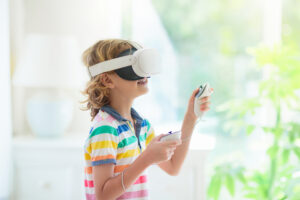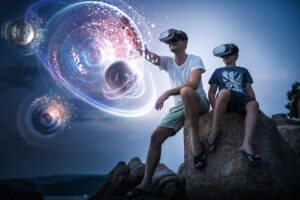Why VR Learning is Ideal for Visual, Auditory, and Kinesthetic Learners

Every student has a unique learning style that influences how they absorb and retain information. Traditionally, education has relied heavily on textbooks and lectures, which may not fully engage all types of learners. Virtual reality (VR) learning, however, provides an immersive experience that caters to various learning styles—visual, auditory, and kinesthetic—offering students an opportunity to interact with lessons in a way that best suits their needs. Here’s how VR enhances learning for each of these styles.
Visual Learners: Seeing Concepts Come to Life
Visual learners absorb information best when they can see and interpret images, diagrams, or charts. Traditional classrooms offer visual aids such as whiteboards and slideshows, but VR takes this to another level by creating fully immersive, 3D environments that students can explore.
- Realistic Simulations – Instead of looking at pictures in a textbook, students can experience historical events, visit faraway places, or observe scientific phenomena up close.
- Enhanced Spatial Understanding – VR allows students to see objects from all angles, improving comprehension of subjects like geometry, anatomy, and astronomy.
- Dynamic Visual Cues – Moving animations and interactive graphics help reinforce key concepts, making complex topics easier to understand and remember.
By placing students inside the content, VR transforms passive observation into active engagement, ensuring that visual learners grasp and retain information more effectively.
Auditory Learners: Engaging Through Sound
Auditory learners retain information best through listening. While traditional teaching methods like lectures and discussions support this style, VR enhances auditory learning by incorporating spatial audio and interactive dialogue.
- Immersive Narration – Lessons are often guided by live audio from teachers also in the VR session, helping students process information as they explore a virtual setting.
- Multisensory Reinforcement – VR experiences combine audio with visual and interactive elements, reinforcing key concepts through multiple channels.
- Scenario-Based Learning – Role-playing simulations allow students to engage in conversations, listen to historical figures speak, or follow step-by-step auditory instructions in real-world simulations.
With VR, auditory learners don’t just listen—they actively engage with sounds in an environment that enhances comprehension and retention.
Kinesthetic Learners: Learning by Doing
 Kinesthetic learners thrive when they can physically interact with materials and engage in hands-on activities. VR provides an ideal platform for experiential learning by allowing students to manipulate objects, conduct experiments, and practice real-world skills in a safe, controlled environment.
Kinesthetic learners thrive when they can physically interact with materials and engage in hands-on activities. VR provides an ideal platform for experiential learning by allowing students to manipulate objects, conduct experiments, and practice real-world skills in a safe, controlled environment.
- Hands-On Exploration – VR enables students to dissect virtual frogs, build molecules, or perform science experiments without limitations.
- Real-World Application – Simulated environments allow learners to practice skills such as performing medical procedures, operating machinery, managing weekly grocery budgets in a market or navigating historical sites.
- Active Participation – Rather than sitting through a lecture, students can move, interact, and engage with lessons in ways that reinforce muscle memory and cognitive connections.
By transforming lessons into fully interactive experiences, VR empowers kinesthetic learners to grasp concepts through movement and direct engagement.
The Future of Personalized Learning
One of the biggest advantages of VR learning is its ability to adapt to different learning styles simultaneously. Students are no longer confined to a one-size-fits-all approach. Instead, they can engage with lessons in a way that aligns with their natural strengths. Whether a student learns best by seeing, hearing, or doing, VR provides a flexible, immersive, and engaging environment that fosters deeper understanding and retention.
At Optima Academy Online, we embrace the power of VR to create meaningful educational experiences for all learners. By integrating immersive learning into our curriculum, we ensure that students are not just consuming information—they are experiencing it in a way that makes learning come alive.
Ready to experience the future of education? Explore our VR-powered courses today!
